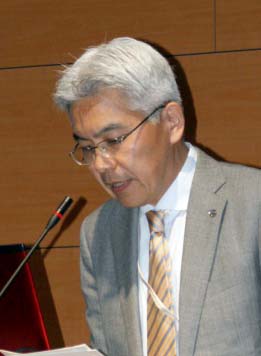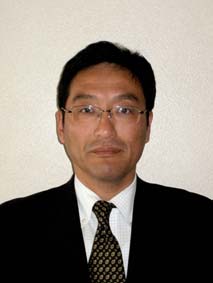[include-page id=”27802″]
Symposium 3 «Abstract»
“To strengthen the Japanese Livestock Industry’s capacity
for disaster management”
Date: Mon. 20th July 10:00~13:00
Venue: Lounge
Organiser: Japanese Animal Hospital Association/Public Interest Incorporated Association Knots
Purpose: When faced with a natural disaster, the Japanese livestock industry was asked by many citizens to save livestock animals. They are bred to support our lifestyles and we must consider this role when dealing with disaster management. However, assisting the evacuation of these animals affected by the disaster is not an easy task for a multitude of reasons, so it is important to recognize risks in advance and constantly endeavor to minimize the effect on livestock even if they are struck directly by a natural disaster. In this session, we will discuss how to find a suitable solution for the Japanese livestock industry.
<Chairperson’s Message>
 Kenji OYAMA (Professor, Graduate School of Agricultural Science, Kobe University)
Kenji OYAMA (Professor, Graduate School of Agricultural Science, Kobe University)
We live in a nation that is likely to experience many natural disasters, such as earthquake, flood, or eruption. Once the disaster strikes, the livestock can be suffered as well as pets and human beings. We can easily remember the heartbreaking suffered livestock resulted from the accident at Fukushima No. 1 Nuclear Plant triggered by the Great East Japan Earthquake. Livestock in Hyogo was damaged by Typhoon No. 23 in October, 2004 although they were not suffered severely by Great Hanshin Earthquake. In addition, we should be aware that they can be even suffered by the disasters occurred in overseas because livestock production in Japan is characterized by value-adding industry with a vast amount of imported feed.
We keep the livestock mainly to support our food production. This property of livestock differs from that of the pets. On the other hand, just like the pets’ owners, the livestock raisers also treat their animals with affection until the animals end their roles for human beings. Therefore the raisers try not to abandon the animals and desire to take care of them to the last. However, how should we treat livestock when we encounter a kind of disaster that we have to leave home? To evacuate animals many significant problems are found in transportation, alternative site, feed, animal wastes, etc. Moving animals requires the understanding from the neighbors and the problem is not just for the people involving livestock production. Thus, a practical and usual solution is to keep them at the same location. Although we have seen TV news showing the animals that are left in evacuation zone, such problems are not well discussed in the whole society.
Man-made disaster often enlarges the damage of natural disasters. It may be impossible to prevent the occurrence of natural disaster, but possible to reduce the damage through making every effort to predict or prepare for disasters. Cattle, swine, and chicken are the representative livestock in Japan, and 3.95, 9.53, and 308.08 million individuals are kept, respectively (MAFF). Asking the opinion from various fields, let us consider what we should do to prepare for the damage of disaster to livestock.
“How we should handle live stock animals to cope with the risk by the natural disaster?”
 Shiro INUKAI (General Manager of Livestock Improvement Division, National Livestock Breeding Center)
Shiro INUKAI (General Manager of Livestock Improvement Division, National Livestock Breeding Center)
Japan has been attacked by the natural disaster such as typhoons and earthquake frequently, because of geographical, topographical and meteorological conditions. Japanese put tremendous efforts to improve society’s capabilities to respond to disasters and mitigate vulnerabilities to disasters by developing disaster management systems, promoting national land conservation, improving weather forecasting technologies. Recent natural disaster events made us to aware importance of the actions to save our own life, because we made a great sacrifice. How the efforts to save life of livestock animals are promoted reacently?
The number of people who does not familiar with Livestock farming and livestock animal seems to be increasing, because of the enlargement of the scale with livestock farming is developing to increase the profits, the number of livestock farm is decreasing and livestock farms are forced to move in the suburbs to avoid the animal waste problem such as bad smells.
We hear the request to save the life of livestock animals during the natural disaster events. However, there are no facilities which will keep livestock animals similarly with the pet-hotels during the disaster, despite most of livestock animals are kept in the shelters in Japan. To consider how to respond to the natural disaster events, economical view point is important, because livestock animals are kept with economical reasons.
The progress of internationalization of agriculture forces Japanese livestock industry to increase the dependency on the imported feed and breeding stock. This situation increases the risk of domestic livestock farming to be affected directly or indirectly by the natural disaster events in overseas.
This time, I would like to point out the factors which become an obstacle to assist the evacuation of livestock animals and discuss what we will be able to do to improve the capabilities to respond to national disasters of Japanese livestock industry.
“External Support by National Livestock Breeding Center (Incorporated Administrative Agency)”
 Tsutomu YOSHIZAWA (National Livestock Breeding Center Kumamoto Station)
Tsutomu YOSHIZAWA (National Livestock Breeding Center Kumamoto Station)
The National Livestock Breeding Center (“NLBC”) provides, by request, external support when livestock contracts infectious diseases or in the event of natural disasters, based on the NLBC`s medium-term objective which is ordered and revised every five years by the Ministry of Agriculture, Forestry and Fisheries.
NLBC is able to start its external supports immediately after the events, because NLBC has experts for animal handling, excellent breeding animals and hays for private consumption.
To step forward the external supports successfully, cooperation among the stake holders is required. Fortunately, NLBC has many staffs that have necessary experiences to take a leadership role in the group.
During the external support, NLBC is required to cope with both the supports and other mission, because there are non-affected areas and continuous efforts are required to improve the livestock animals. NLBC has to avoid the risk to allow the infectious of the disease
which is caused by the external supports.
As for above mentioned reasons, NLBC supply its stuffs, excellent breeding animals and roughage. The Kumamoto Station brings up excellent breeding stock of Japanese Brown Cattle from the peace time, to support the risk aversion by the Kumamoto Prefecture.
Currently, not only to minimize the impact of the disaster but also the importance of resilience, which allows smooth restoration and reconstruction, is recognized and necessary efforts to improve the national resilience are continuing in Japan. To follow these current streams, I think NLBC should consider how to conduct the external supports not only with the view of immediate gain but also the resumption of livestock farming.
So, NLBC will improve its external support structure to reflect the past experiences such as the eruption of Mt. Shinmoe in 2011, the outbreak of foot-and-mouth disease in 2010, the Great East Japan Earthquake in 2011 and the outbreak of avian influenza in 2014 and 2015.
“Supplying Animals with Formula and Mixed Feed just after the Great East Japan Earthquake”
 Tsutomu HASEGAWA (Chief General Manager, Japan Feed Manufacturers Association)
Tsutomu HASEGAWA (Chief General Manager, Japan Feed Manufacturers Association)
By the Great East Japan earthquake, livestock feed industries in the Pacific side of Tohoku Kanto district, and between Hachinohe port in Aomori prefecture and Kashima port in Ibaraki prefecture, were severely damaged. Those areas have 28 feed mills in 5 industrial district, and they produce one third of formula and mixed feed in Japan.
If a supply of the feed delivered daily from the feed mills to livestock farming stops, it will cause more damage on cattle, swine, and chicken industries. Therefore, devastated feed mills speeded up the repair, and the entire livestock feed manufacturing industry urgently provided a backup system across the country.
In particular, to secure livestock feed supply of 10,000 tons per day (Ministry of Agriculture, Forestry and Fisheries of Japan: hereinafter called MAFF) for Tohoku area, they organized a system to increase production of formula and mixed feed in the areas of western Japan, Kyushu district, as well as Hokkaido. Also, they prepared for long distance transport in a week after the earthquake.
In addition, they gave fully support, including offering a loan of 350,000 tons of feed grain as an extra supply of raw materials, getting a special permission to use freeways, securing of raw materials, and delivering livestock feed to the devastated areas in cooperation with MAFF and Ministry of Land, Infrastructure, Transport and Tourism.
On the other hand, it was a problem to build the infrastructure needed to “distribute electricity, fuel, and water”, necessary for both humans and animals at the disaster. The problem was whether they could “distribute electricity, fuel, and water” in priority to grain silos, feed mills, farming plants, and farm producers. Even though they wanted to deliver, there was a situation in which they were unable to fill up gas, missing of domestic vessels for marine transit, and lack of packing materials needed for the transportation of livestock feed.
The livestock industry in Japan has been relying on external assistance, and 24 million tons of raw materals for formula and mixed feed, the most critical to livestock, are almost imported. Most livestock feed mills are located on port areas. It is because we import corn, consisting of more than 40 percent of raw materials. Therefore, there is a potential for tremendous impact on livestock in case of disaster on port areas. Not to be influenced by exchange rates, climate conditions, and product trends affected by disasters in foreign countries, we need to establish a firm footing for feedstuff. It is crucially important to increase home grown raw materials such as rice for animal consumption.
“About the cooperation system in the areas at the time of the disaster”
 Yoshitaka HONDA (Hyogo Prefectural government, Agricultural Environment Department, Agriculture, Forestry and Fisheries Bureau, Livestock Division hygiene feed group leader)
Yoshitaka HONDA (Hyogo Prefectural government, Agricultural Environment Department, Agriculture, Forestry and Fisheries Bureau, Livestock Division hygiene feed group leader)
Human damage by Hanshin Awaji great earthquake disaster was big, but domestic animal damage was hardly. The cause of big damage in stockbreeding was what circulation of feed and raw milk stopped and disaster of Kobe harbor, feed factories and milk factories.
There was support of feed securement from many areas and damage of stockbreeding was suppressed.
For economic damage, damage of domestic animals and agricultural facilities has been reduced by the agricultural mutual aid system.
As for the damage of domestic animals and agriculture facilities, economical support is made by agricultural insurance.
Risk by Domestic Animal Infectious Diseases is increasing in recent years. In last winter High Pathogenic Avian Influenza (HPAI) occured at 5 prefectures and killing disposal was done. Because damage expands when the Domestic Animal Infectious Diseases are different from other accidents, we use to get cooperation of many engines and deal quickly.
In East Asia HPAI and Foot-and-Mouth Disease continue, and we can’t be relieved. About the coalition of occurring, we confirm the prevention of epidemics practice and holding of an area conference every year.

